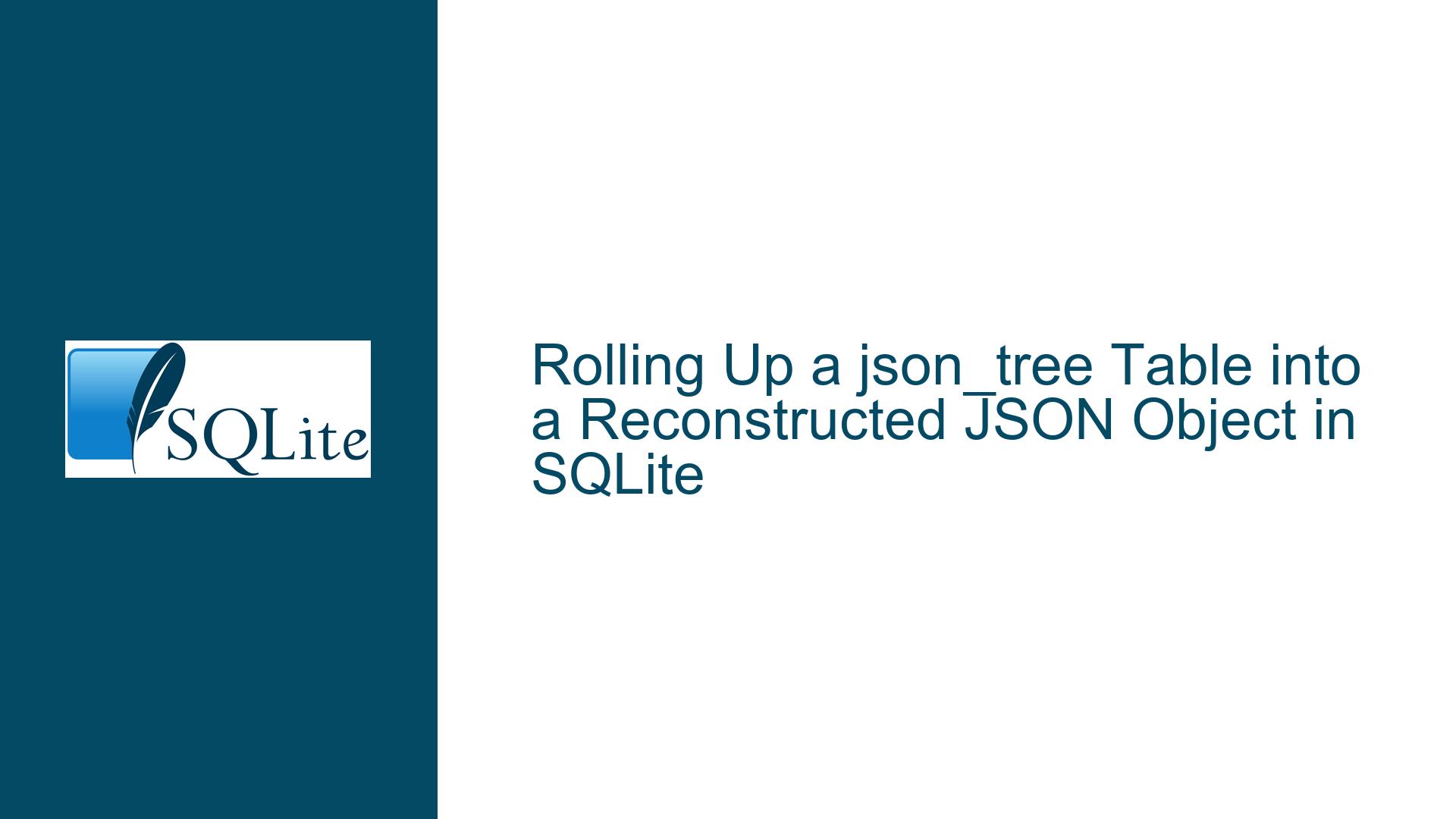Rolling Up a json_tree Table into a Reconstructed JSON Object in SQLite
Issue Overview: Reconstructing a JSON Object from a Modified json_tree Table
The core issue revolves around reconstructing a JSON object from a modified json_tree table in SQLite. The original JSON object is disassembled into a hierarchical structure using the json_tree function, modified at specific nodes, and then needs to be rolled back into a complete JSON object. The challenge lies in the recursive reconstruction of the JSON object, ensuring that the modified values are correctly integrated into the final structure.
The process involves three main steps: disassembling the JSON object into a json_tree table, modifying specific nodes within this table, and then reconstructing the JSON object from the modified table. The first two steps are straightforward, but the third step—reconstructing the JSON object—requires a recursive approach to ensure that the hierarchical relationships are preserved and the modifications are correctly applied.
The difficulty arises from the need to traverse the hierarchical structure in a depth-first manner, starting from the deepest nested objects and working upwards to the root. This traversal ensures that each node is correctly integrated into its parent’s value field, preserving the structure of the original JSON object. The recursive nature of this process makes it complex, especially when dealing with deeply nested structures.
Possible Causes: Challenges in Recursive JSON Reconstruction
The primary challenge in reconstructing the JSON object from a modified json_tree table lies in the recursive nature of the process. The json_tree function breaks down the JSON object into a flat table, where each row represents a node in the JSON hierarchy. This flat structure needs to be traversed and reconstructed back into a nested JSON object, which requires a recursive approach.
One of the main causes of difficulty is the need to maintain the hierarchical relationships between nodes. In a flat table, the relationships between parent and child nodes are represented by the parent and id columns. However, reconstructing these relationships into a nested JSON object requires a recursive traversal of the table, starting from the leaf nodes and working upwards to the root.
Another challenge is the modification of specific nodes within the json_tree table. These modifications need to be correctly integrated into the final JSON object, which requires careful handling of the key and value fields. The json_set function is used to update the JSON object, but it requires the correct path to the node being modified. This path is derived from the fullkey field in the json_tree table, which represents the path to the node within the original JSON object.
The use of recursive CTEs (Common Table Expressions) adds another layer of complexity. Recursive CTEs are powerful tools for traversing hierarchical structures, but they require careful handling to ensure that the recursion terminates correctly and that the results are accumulated in the desired manner. In this case, the recursive CTE needs to traverse the json_tree table in a depth-first manner, starting from the leaf nodes and working upwards to the root, while accumulating the results into a single JSON object.
Troubleshooting Steps, Solutions & Fixes: Recursive Reconstruction of JSON Objects
To address the challenge of reconstructing a JSON object from a modified json_tree table, the following steps can be taken:
Step 1: Disassemble the JSON Object into a json_tree Table
The first step is to disassemble the original JSON object into a flat table using the json_tree function. This function breaks down the JSON object into a table where each row represents a node in the JSON hierarchy. The resulting table will have columns such as key, value, type, parent, and id, which represent the key-value pairs, the type of the node (e.g., object, array, string, etc.), the parent node, and the unique identifier for the node, respectively.
For example, consider the following JSON object:
{
"name": "John",
"age": 30,
"address": {
"street": "123 Main St",
"city": "Anytown"
}
}
The json_tree function will break this down into a table with the following rows:
| key | value | type | parent | id |
|---|---|---|---|---|
| {object} | object | NULL | 1 | |
| name | John | text | 1 | 2 |
| age | 30 | integer | 1 | 3 |
| address | {object} | object | 1 | 4 |
| street | 123 Main St | text | 4 | 5 |
| city | Anytown | text | 4 | 6 |
**Step 2: Modify Specific Nodes in the json_tree Table**
Once the JSON object is disassembled into a `json_tree` table, specific nodes can be modified based on user input or other criteria. For example, suppose we want to modify the `city` field in the `address` object to "Newtown". This can be done by updating the `value` field of the corresponding row in the `json_tree` table.
The modified table would look like this:
| key | value | type | parent | id |
|---------|--------------|--------|--------|----|
| | {object} | object | NULL | 1 |
| name | John | text | 1 | 2 |
| age | 30 | integer| 1 | 3 |
| address | {object} | object | 1 | 4 |
| street | 123 Main St | text | 4 | 5 |
| city | Newtown | text | 4 | 6 |
Step 3: Reconstruct the JSON Object from the Modified json_tree Table
The final step is to reconstruct the JSON object from the modified json_tree table. This requires a recursive approach to traverse the table in a depth-first manner, starting from the leaf nodes and working upwards to the root. The goal is to build the JSON object by integrating each node into its parent’s value field.
To achieve this, a recursive CTE can be used. The CTE will start with the leaf nodes (nodes with no children) and work its way up to the root, accumulating the results into a single JSON object. The json_set function is used to update the JSON object at each step, ensuring that the modified values are correctly integrated.
Here is an example of how this can be done:
WITH RECURSIVE defs_resolved AS (
SELECT
ROW_NUMBER() OVER (ORDER BY parent, id) AS rowid,
key,
value,
type,
parent,
id,
fullkey
FROM json_tree('{
"name": "John",
"age": 30,
"address": {
"street": "123 Main St",
"city": "Anytown"
}
}')
),
defs_folded AS (
SELECT rowid, json_object() AS result
FROM defs_resolved
WHERE rowid = 1
UNION ALL
SELECT nr.rowid, json_set(defs_folded.result, nr.fullkey, json(nr.value)) AS result
FROM defs_resolved nr
JOIN defs_folded
ON nr.rowid = defs_folded.rowid + 1
)
SELECT result
FROM defs_folded
WHERE rowid = (SELECT MAX(rowid) FROM defs_folded);
In this example, the defs_resolved CTE is used to assign a rowid to each row in the json_tree table, ensuring that the rows are processed in the correct order. The defs_folded CTE is then used to recursively build the JSON object, starting with an empty JSON object and adding each row from the defs_resolved table in sequence. The json_set function is used to update the JSON object at each step, ensuring that the modified values are correctly integrated.
The final result is a fully reconstructed JSON object, with the modified values correctly integrated into the structure. This approach ensures that the hierarchical relationships between nodes are preserved and that the modifications are correctly applied.
Conclusion
Reconstructing a JSON object from a modified json_tree table in SQLite is a complex task that requires a recursive approach. By disassembling the JSON object into a flat table, modifying specific nodes, and then reconstructing the JSON object using a recursive CTE, it is possible to achieve the desired result. The key is to carefully handle the hierarchical relationships between nodes and to ensure that the modifications are correctly integrated into the final JSON object. With the right approach, this task can be accomplished efficiently and effectively.






